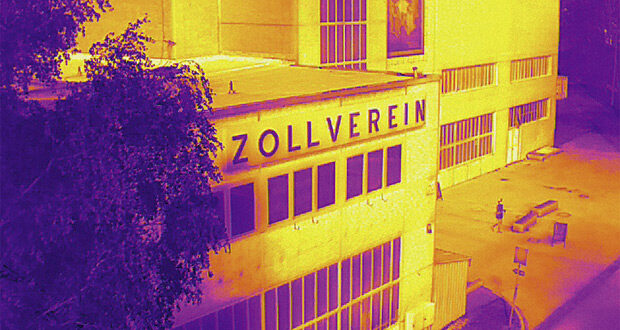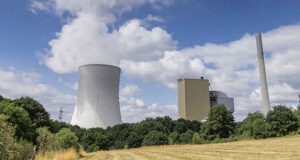Drone pilot Bodo Bernsdorf sees the world through different eyes. When he lets his special copter soar high above the grounds of the Zollverein coking plant in Essen/Germany, he not only encounters the chimneys and pipelines at flying height – he also finds damaged areas that are not even visible to the naked eye (Figure 1). The drone’s high-resolution images reveal how the industrial monument is really doing and where remediation is needed. That is at least the theoretical approach. Bernsdorf and his team from the Research Center of Post-Mining (FZN) at the TH Georg Agricola University (THGA), Bochum/Germany, want to detect material damage without leaving any traces themselves. In the new research cooperation “KoKo Zollverein” (short for “Copter flights on the Zollverein coking plant”), the FZN is developing and testing this new methodology. To this end, the experts are working closely with the Zollverein Foundation and the Materials Science Research Department of the German Mining Museum Bochum (DBM) in Bochum. Satellite images and non-destructive lasers will also be used in the troubleshooting process. Ultimately, the aim is to carry out a detailed examination of the building fabric and damage assessment for the first time.
For more than 30 years, coke, gas and other by-products were produced at the Zollverein coking plant in Essen. During peak operation, it was considered one of the most modern coking plants in Europe. Today, the plant is an architectural monument that, together with the neighboring Zollverein coal mine, has been declared a UNESCO World Heritage Site. “In addition to the cultural play and development of Zollverein, the preservation, safeguarding and protection of the UNESCO World Heritage Site is our top priority,” says Prof. Hans-Peter Noll, Chairman of the Board of the Zollverein Foundation. “Zollverein is a place of change and the future, so it is a perfect fit that a research cooperation is now testing cutting-edge technology in this huge real laboratory, which will soon open up new possibilities for other industrial-cultural sites.”
“The Zollverein World Heritage Site is a breath-taking landmark and an important witness to industrial innovation in our region” says Prof. Tobias Rudolph, project manager at FZN. “Every time we are on site with our scientific team, we get completely new perspectives. We are now expanding that with a sensor view from above and inside.” Indeed, it’s not just the outdoor facilities that are coming under the microscope; the interiors will also be evaluated. To do this, the drones take optical, thermal and multispectral resolution images that allow conclusions to be drawn about the condition of the materials. Where can rust be found? Where is verdigris or spalling? What is the overall condition of the objects? “At best, we can visualize all of this and then make a recommendation as to where the need for renovation is most urgent,” Bernsdorf explains.
For a holistic picture, FZN experts fuse drone data with satellite images from the European Copernicus program, which provide important information about the daytime surface. In addition, they combine the information from the air with on-site measurements in which a laser scanner scans the individual objects centimeter by centimeter. “For the first time, we are thus bringing together expertise from the fields of geomonitoring and materials science at a cultural and historical site. The idea of detecting material damage by interpreting and correlating various drone-mounted sensors together in a network is thereby a completely new approach in the field of historic preservation,” explains Prof. Rudolph enthusiastically. If successfully applied, the method will be transferred to other industrial heritage sites. (THGA/Si.)


